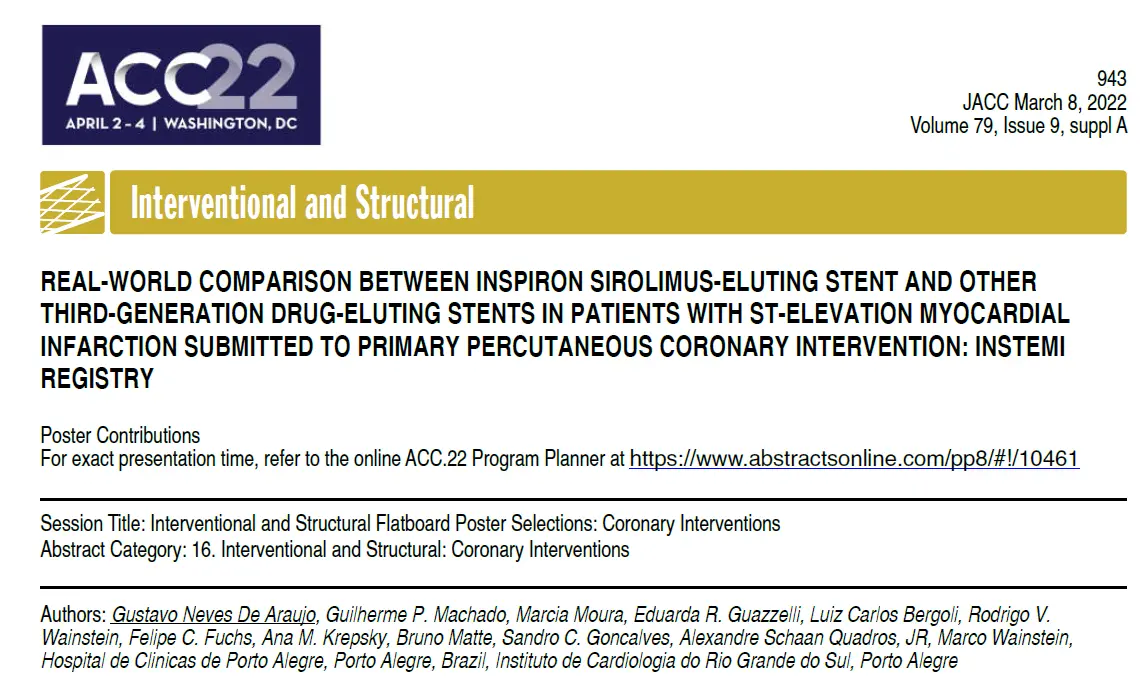
Poster Contributions
For exact presentation time, refer to the online ACC.22 Program Planner at https://www.abstractsonline.com/pp8/#!/10461
Session Title: Interventional and Structural Flatboard Poster Selections: Coronary Interventions
Abstract Category: 16. Interventional and Structural: Coronary Interventions
Authors: Gustavo Neves De Araujo, Guilherme P. Machado, Marcia Moura, Eduarda R. Guazzelli, Luiz Carlos Bergoli, Rodrigo V. Wainstein, Felipe C. Fuchs, Ana M. Krepsky, Bruno Matte, Sandro C. Goncalves, Alexandre Schaan Quadros, JR, Marco Wainstein, Hospital de Clinicas de Porto Alegre, Porto Alegre, Brazil, Instituto de Cardiologia do Rio Grande do Sul, Porto Alegre
Background: Coronary drug-eluting stents are continuously developing, and the current gold standard consists of new metal alloys with thinner struts and bioresorbable polymers. Newer devices need real world comparisons with other well-established DES in order to confirm its effectiveness. Our aim was to compare a new ultrathin strut, sirolimus-eluting stent (InspironTM, Scitech, Brazil) with other thirdgeneration drug-eluting stent platforms in patients with ST-elevation Myocardial Infarction (STEMI) submitted to primary percutaneous coronary intervention (PCI).
Methods: The present work assessed clinical outcomes from a STEMI multicenter registry, from two centers in southern Brazil. Patients were considered for inclusion if they were admitted with STEMI and were submitted to primary PCI. All patients included received third generation DES, and InspironTM was compared with five other stent platforms. A propensity score matching (PSM) was computed to produce similar groups in relation to clinical and procedural characteristics.
Results: From January 2017 to June 2020, 1711 patients have undergone primary PCI and 1548 patients matched our entry criteria (771 in the InspironTM and 777 in the other third generation DES). At follow up, patients in InspironTM group had lower rate of 30-day mortality (RR 0.534 [0.38 – 0.74], p < 0.01), new myocardial infarction (RR 0.69 [0.48-0.84], p = 0.02) and stroke (RR 0.38 [0.27-0.84], p = 0.01) in the unadjusted analysis. After PSM, the study sample was comprised of 1506 patients (752 in the InspironTM and 754 in the other third generation DES`s, 4% loss). The rates of 30-day mortality (HR 0.796, CI 0.537 – 1.179, p = 0.25), new MI (HR 0.1.139, CI 0.587 – 2.210, p = 0.70), stroke (HR 0.625, CI 0.304 – 1.287, p = 0.20) and stent thrombosis (HR 1.002, CI 0.701 – 1.431, p = 0.993) were similar between groups. Neither individual components of MACE (all-cause death, MI and TVR) nor subgroup analysis showed significant differences between groups.
Conclusion: Our findings support that InspironTM is safe in patients with STEMI, with similar outcomes in the treatment with primary PCI at a mid-term follow-up.

